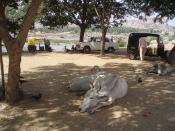What is the nature of Mughal rule in India 1500-1750?
At around 1500 A.D. India was advancing rapidly. Trade linked much of India and internal commerce was doing well. Different regions in India grew a variety of crops as well as production of items such as cotton and silk increased. Indian goods where demanded on the open market and Indian imports where few compared to their exports. Some of these imports included horses, black slaves and ivory from Africa. Slowly but surely India's economy was growing. India's weakness lay in its political disunity, divided it could not withstand nor discourage an invasion.
The invasion inevitably came. The leader of this legendary force was Babur, the son of Shaikh Mirza a man who was able to trace his bloodlines all the way back to Timur and his connection to Genghis Khan. Babur's initial holdings where of a small kingdom north of the Oxus in Ferghana, east of the modern city of Tashkent.
His first conquest was to be Samarkand however the Uzbek tribes in the area quickly drove him off the land all the way to Kabul. He didn't much care for Kabul but Timur himself had launched his invasion of Samarkand from Afghanistan. From there he would make repeated assaults on Samarkand in which both times he would be driven back. Once Babur's position in Kabul is secured he seeks to explore out new lands. At this point Babur make's a few raids into the Hindus valley via Kyber pass in search of plunder. What he found was forces that he deemed weak, he chose to stay. In 1525 Babur launches his successful bid for "Hindustan". Babur's forces where highly mobile and where veterans of his exploits in central Asia, they numbered around twelve thousand men.


